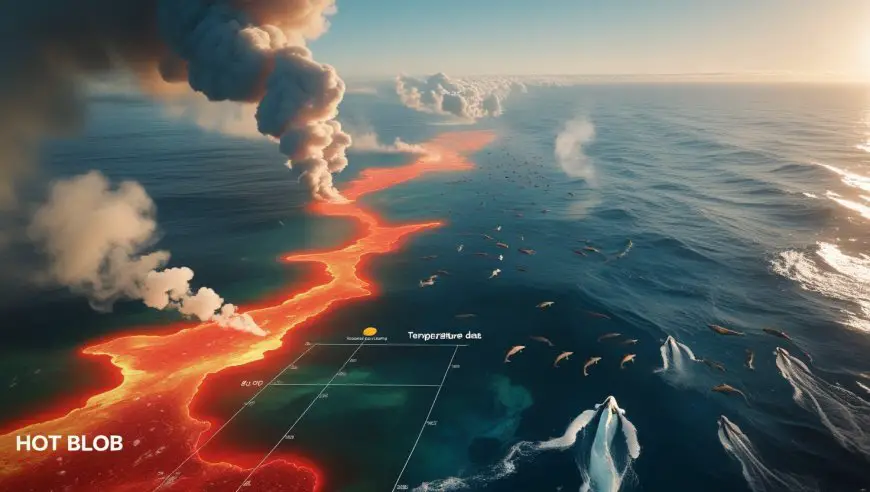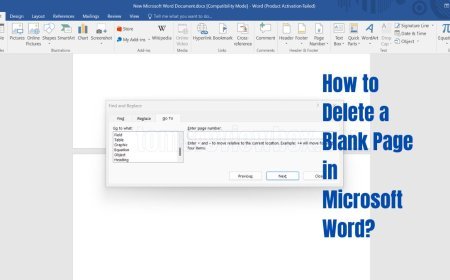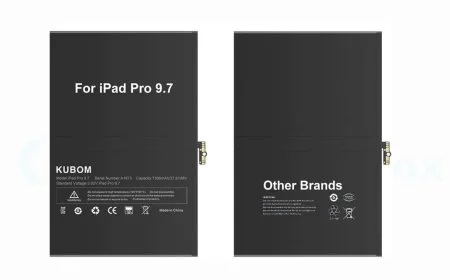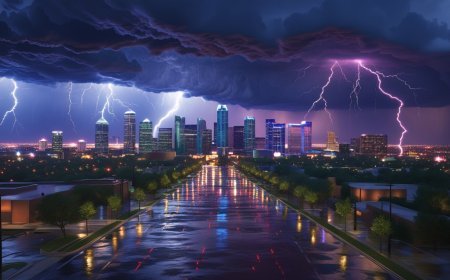Hot Blob in the Pacific: Causes, Effects, and What Scientists Fear Next
Discover the 'Hot Blob,' a massive Pacific Ocean heatwave. Learn its causes, devastating marine ecosystem impact, and what a potential hot blob 2025 means for our planet.

Have you ever felt the ocean and thought it was a little too warm, like bathwater? While a warm dip can be nice, when a vast expanse of the ocean heats up by several degrees and stays that way for months or even years, it’s a sign that something is seriously wrong. Meet the "Hot Blob"—a phenomenon with a quirky name but devastating consequences. It's not a monster from a sci-fi movie; it's a real and recurring **marine heatwave** in the Pacific Ocean, and it’s giving scientists and coastal communities major cause for concern.
This isn't just a distant problem for scientists to ponder. The Blob's influence reaches from the microscopic plankton at the base of the food chain right to the weather you experience and the seafood on your plate. Let's dive deep into what this **blob phenomenon** is, where it came from, and why the prospect of a **hot blob 2025** has everyone watching the ocean with bated breath.
What is the Pacific Ocean's 'Hot Blob'?
The term "Hot Blob" was coined in 2014 by Washington state climatologist Nick Bond. He used it to describe an enormous, stubborn patch of water in the Northeast Pacific Ocean that was significantly warmer than average. At its peak, this mass of water was over 1,000 miles across and 300 feet deep, with temperatures soaring up to 4°C (7°F) above normal. This is what's known as a **sea surface temperature anomaly**.
Think of it like the ocean having a high fever. Normally, the ocean's temperature fluctuates with the seasons, but this was different. This fever persisted for years, from late 2013 through 2016, disrupting the marine world in ways we're still working to understand. It was the largest and longest-lasting **marine heatwave** on record, and it served as a shocking preview of the widespread **climate change effects** on our oceans.
Decoding the Blob: What Causes This Pacific Ocean Heatwave?
The Blob wasn't born in a vacuum. Its formation was a perfect storm of atmospheric weirdness coupled with a troubling underlying trend.
The Culprit: A Stubborn High-Pressure Ridge
The immediate trigger for the original Blob was an unusually persistent high-pressure system in the atmosphere, nicknamed the "Ridiculously Resilient Ridge." This atmospheric wall set up camp over the Northeast Pacific and refused to leave.
- Blocked Storms: This ridge deflected winter storms that would normally travel across the Pacific to the coast. These storms churn up the ocean, mixing colder, deeper water with warmer surface water. Without them, the surface layer just sat there and baked in the sun.
- Calm Winds: The high-pressure system also led to weaker winds. Strong winds typically help cool the ocean's surface through evaporation. With calmer conditions, less heat escaped.
Essentially, the ocean's natural air conditioning system was switched off for an extended period, allowing an unprecedented amount of heat to build up.
The Underlying Condition: Global Warming and Ocean Warming
While the "Ridiculously Resilient Ridge" was the direct cause, the stage was set by decades of **global warming ocean** effects. Our oceans have absorbed over 90% of the excess heat trapped by greenhouse gases since the 1970s. This means the baseline temperature of the Pacific is already higher than it used to be.
So, when a natural variation like a strong high-pressure ridge occurs, it's now happening on top of an already warmer ocean. This makes the resulting **marine heatwave** hotter, larger, and longer-lasting than it would have been a century ago. It’s the difference between getting a minor cold and getting a severe case of pneumonia because your immune system was already compromised.
A Fisherman's Tale: Witnessing the Blob's Impact Firsthand
For Joe, a third-generation cod fisherman from the Gulf of Alaska, the ocean wasn't an abstract concept studied on a chart; it was his life, his office, and his family's legacy. In 2014 and 2015, he started noticing things were... off. The familiar grey, chilly waters felt strangely tepid. His nets, usually heavy with Pacific cod, came up unusually light. Instead, they were filled with species he rarely saw so far north, like sunfish and pomfret—fish that preferred warmer waters.
The seabirds that normally swarmed his boat seemed lethargic and thin. He heard reports from up and down the coast of starving sea lion pups washing ashore. The entire rhythm of the ecosystem he knew so intimately felt out of sync. It wasn't just a bad year; it was as if the ocean itself was sick. Joe was witnessing the **marine ecosystem impact** of the Hot Blob in real-time. The scientific data that came later only confirmed what he and other fishers already knew in their bones: their world had fundamentally changed.
The Cascade of Chaos: Marine Ecosystem Impact
A few degrees of warming might not sound like much, but for marine life adapted to specific temperature ranges, it’s a life-or-death situation. The Blob triggered a catastrophic chain reaction.
The Food Web Collapse
The entire marine food web in the Northeast Pacific is built on a foundation of cold, nutrient-rich water. The Blob turned this upside down.
- Plankton Problems: The warm surface layer acted like a lid, preventing nutrients from the deep from mixing upwards. This starved the phytoplankton—the microscopic plants that form the base of the food chain. The types of phytoplankton also changed, favoring smaller, less nutritious species.
- Zooplankton Starvation: The zooplankton (tiny animals) that feed on phytoplankton, particularly large, fatty copepods, disappeared. These are the "hamburgers" of the sea, a critical food source for small fish.
- Domino Effect Upward: With their primary food source gone, populations of forage fish, salmon, and cod plummeted. This, in turn, led to mass starvation events for their predators. An estimated one million common murres, a type of seabird, died. Sea lion and fur seal populations suffered immensely. The collapse echoed all the way to the top of the food chain.
Toxic Algal Blooms on the Rise
The warm, stagnant conditions created by the Blob were the perfect breeding ground for something else: harmful algal blooms (HABs). A massive bloom of the algae *Pseudo-nitzschia* spread along the entire West Coast. This algae produces a potent neurotoxin called domoic acid.
The toxin accumulated in shellfish like crabs, clams, and mussels, as well as in anchovies and sardines. This led to:
- Fishery Closures: Authorities had to close multi-million dollar Dungeness crab and razor clam fisheries for months, devastating coastal economies.
- Wildlife Poisoning: Hundreds of marine mammals, including sea lions and even whales, suffered from domoic acid poisoning, which causes seizures and death.
Weather Weirding on Land
The Blob’s influence didn't stop at the water's edge. That massive pool of warm water released huge amounts of heat and moisture into the atmosphere, influencing weather patterns. It was strongly linked to the severe drought that gripped California from 2011-2017 and contributed to warmer winters and reduced snowpack in the Pacific Northwest, affecting water supplies and ski resorts.
The Hot Blob in Numbers: A Look at the Data
The scale of the 2013-2016 **pacific ocean heatwave** was staggering. Here’s a snapshot of the key metrics that scientists tracked.
| Metric | Measurement | Significance |
|---|---|---|
| Peak Temperature Anomaly | Up to 4°C (7.2°F) above average | Pushed many marine species far beyond their tolerance levels. |
| Maximum Area Covered | Approx. 4 million square kilometers | An area larger than the entire country of India, affecting a huge portion of the Pacific ecosystem. |
| Duration | Late 2013 to Early 2016 | The prolonged nature prevented ecosystems from recovering, causing cumulative stress and damage. |
| Key Economic Impact | >$100 Million loss to West Coast Dungeness Crab Fishery | Demonstrates the direct economic consequence of the **marine ecosystem impact**. |
Data sourced from various NOAA and scientific publications on the 2013-2016 Northeast Pacific marine heatwave.
Hot Blob Myths vs. Facts
Because of its dramatic nature, several misconceptions have sprung up around the Blob. Let’s clear the water.
Myth 1: It's just a natural cycle, it has nothing to do with humans.
FACT: While atmospheric ridges are natural, their intensity and the severity of the resulting **ocean warming** are not. A 2016 study found that the heatwave's magnitude was "only possible due to anthropogenic warming." The underlying warmer ocean, a direct result of human activity, turns a normal weather pattern into an extreme, catastrophic event.
Myth 2: It's just a patch of warm water in the ocean, it can't affect me on land.
FACT: As we've seen, the Blob's impact is far-reaching. It altered weather patterns, contributing to drought and changing winter conditions. It crippled fisheries, impacting food prices and the livelihoods of thousands. The health of the ocean is directly linked to the health of our planet and society.
Myth 3: The Blob is gone, so the problem is solved.
FACT: The original Blob dissipated, but the ocean's memory is long. Some fish stocks, like Pacific cod, have yet to recover. Furthermore, the conditions that created it haven't gone away. Several other significant marine heatwaves have occurred in the Pacific since 2016, though none have yet matched the first Blob's longevity. It wasn't a one-off event but rather the first major warning shot.
What Scientists Fear Next: The Rise of the 'Hot Blob 2025' and Beyond ????
The most chilling takeaway from the Hot Blob is that it's a window into our future. As the baseline of **global warming ocean** temperatures continues to rise, scientists are not asking *if* another Blob will happen, but *when*, and how bad it will be. The term **hot blob 2025** isn't a specific prediction for that exact year, but rather a placeholder for the next major, long-duration event that scientists know is coming.
Here’s what they fear for the next big one:
- More Frequent and Intense Events: What was once a 1-in-1000 year event could become a 1-in-10 year event, or even more frequent.
- Permanent Ecosystem Shifts: If heatwaves become the new normal, ecosystems may not have time to recover in between. This could push them past a tipping point, leading to a permanent shift from a rich, diverse system (like a kelp forest) to a less productive, "weedy" state (like a turf-algae-dominated seafloor).
- Compound Disasters: The next Blob could coincide with a strong El Niño event, another natural warming pattern. The combined warming could be unlike anything we have ever seen, with truly unpredictable and devastating consequences for marine life and global weather.
Conclusion: What Can We Do About Ocean Warming?
The Hot Blob is more than a scientific curiosity; it’s a distress signal from our planet's largest life-support system. It shows in stark detail how **climate change effects** are not a distant future threat but a present-day reality. The health of our oceans is in peril, and because we all depend on them for oxygen, food, and a stable climate, so are we.
Feeling overwhelmed? That's understandable. But helplessness is not our only option. The solution to big problems starts with awareness and collective action. Here’s how you can be part of the change:
- Stay Informed: Continue to learn about **ocean warming** and the challenges our planet faces. Knowledge is the first step toward meaningful action.
- Reduce Your Carbon Footprint: The heat in the ocean comes from heat trapped in our atmosphere. Every action to reduce emissions—whether it's using less energy, choosing sustainable transportation, or reducing waste—helps.
- Support Sustainable Choices: When buying seafood, use guides like the Monterey Bay Aquarium's Seafood Watch to choose species that are fished or farmed in ways that are healthier for the ocean.
- Advocate for Change: Support leaders, policies, and organizations that prioritize climate action and ocean conservation. The scale of this problem requires large-scale, systemic solutions.
The Hot Blob sent us a message, written in overheated water and starving ecosystems. The question now is, will we listen?
Scientific Sources for Further Reading:
- Di Lorenzo, E., & Mantua, N. (2016). Multi-year persistence of the 2014/15 North Pacific marine heatwave. Nature Climate Change, 6(11), 1042-1047.
- NOAA Fisheries: The "Blob" of Warm Water in the Pacific Ocean
- Cavole, L. M., et al. (2016). Biological impacts of the 2013–2015 warm-water anomaly in the Northeast Pacific. Oceanography, 29(2), 273-285.
What's Your Reaction?







































![MacBook Pro M5: All the features and specs you need to know [LEAKS REVEALED]](https://tomsreviewbox.com/uploads/images/202502/image_430x256_67bd6d7cd7562.jpg)



























